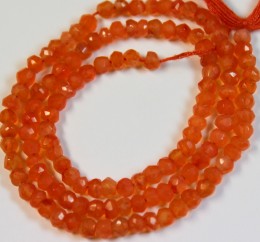183.05 CTS ORTHOCERAS POLISHED SPECIMEN
- SKU
- Afmetingen (mm)
- 69 x 35 x 10mm
- Gewicht (cts)
- Certified Gemstones
- Nee
- Kleuren
-
Patrik's Minerals & Lapidary
POLISHED ORTHOCERAS SPECIMEN
specimen has a nice domed polished face , natural unpolished back
WEIGHT : 183.05 CTS
SIZE MM: 69 X 35 X 10
( 6 MM IS APPROX 1/4 INCH )
CODE : G 3962
Orthoceras was an ancient mollusk that lived more than 400 million years ago. The name means straight horn, referring to the characteristic long, straight, conical shell. The preserved shell is all that remains of this ancestor of our modern-day squid.
The soft body lived in the last open-ended segment at the large end of the conical shell. As the body grew and the housing segment became too small, a dividing wall, called the septa, grew to separate the old chamber from the new one. The differences in the composition of these shell parts allowed for differences in fossilization so the parts can be seen. The siphuncle is a tube that runs the entire length of the shell, through each of the chambers. This tube had two functions. Once filled with water, the nautiloid could force the water out, propelling itself backward with a kind of jet propulsion. By releasing the water and leaving air space, the tube could serve as a bouyancy device allowing the animal to rise and lower itself to different depths. The siphuncle is the line running down the center from head to tail. The septa are the short curved lines that run across or side to side. These straight shelled nautiloids ranged in size from less than a centimeter to more than 14 feet long!
| Verzend provider | Verzending naar Australië | Verzending naar de rest van de wereld | Gecombineerde verzending ( Australië ) | Gecombineerde verzending (rest van de wereld) |
|---|---|---|---|---|
| FedEx |
|
|
|
|
| Registered Shipping |
|
|
|
|
- SKU
- Afmetingen (mm)
- 69 x 35 x 10 mm
- Gewicht (cts)
- Certified Gemstones
- Nee
- Kleuren
-
Patrik's Minerals & Lapidary
POLISHED ORTHOCERAS SPECIMEN
specimen has a nice domed polished face , natural unpolished back
WEIGHT : 183.05 CTS
SIZE MM: 69 X 35 X 10
( 6 MM IS APPROX 1/4 INCH )
CODE : G 3962
Orthoceras was an ancient mollusk that lived more than 400 million years ago. The name means straight horn, referring to the characteristic long, straight, conical shell. The preserved shell is all that remains of this ancestor of our modern-day squid.
The soft body lived in the last open-ended segment at the large end of the conical shell. As the body grew and the housing segment became too small, a dividing wall, called the septa, grew to separate the old chamber from the new one. The differences in the composition of these shell parts allowed for differences in fossilization so the parts can be seen. The siphuncle is a tube that runs the entire length of the shell, through each of the chambers. This tube had two functions. Once filled with water, the nautiloid could force the water out, propelling itself backward with a kind of jet propulsion. By releasing the water and leaving air space, the tube could serve as a bouyancy device allowing the animal to rise and lower itself to different depths. The siphuncle is the line running down the center from head to tail. The septa are the short curved lines that run across or side to side. These straight shelled nautiloids ranged in size from less than a centimeter to more than 14 feet long!
| Verzend provider | Verzending naar Australië | Verzending naar de rest van de wereld | Gecombineerde verzending ( Australië ) | Gecombineerde verzending (rest van de wereld) |
|---|---|---|---|---|
| FedEx |
|
|
|
|
| Registered Shipping |
|
|
|
|

Store items 50% sale Bargains to be had all has to sell , combined shipping for 6 items $18 tracked....
-
 Positief
PositiefExcellent communication with this seller. Fast shipping, and pleased with purchase.
-
 Positief
PositiefExcellent communication with this seller. Fast shipping, and pleased with purchase.
-
 Positief
PositiefExcellent communication with this seller. Fast shipping, and pleased with purchase.
-
 Positief
PositiefPaid and shipped - no feedback left after 100 days
-
 Positief
PositiefPaid and shipped - no feedback left after 100 days










